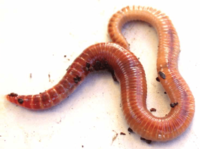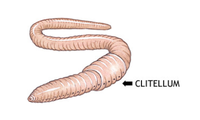Red wiggler worms
Overview
Red wiggler worms, scientifically known as Eisenia fetida, are classified as Annelids. The name fetida means foul-smelling. This comes from the foul smelling fluid they can exude if disturbed.[3] They go by various other common names such as the manure worm, dung worm, tiger worm, etc. They are widely known for their use in compost and as fish bait[5]. They are red-brown in color with alternating stripes. Red wiggler worms can range from 26-130 mm long and 2-6 mm wide. Red wiggler worms feed on organic matter and contribute to the decomposition process.[3]
Classification

Domain: Eukarya
Kingdom: Animalia
Phylum: Annelida
Class: Oligochaeta
Order: Hapliotaxida
Family: Lumbricidae
Genus: Eisenia
Species: Eisenia Fetida
Habitat
Red wiggler worms are Epigeic Earthworms , meaning they live on the upper surface of the soil or in the soil litter[5]. Red wiggler worms prefer moist, organic-rich environments[7]. Manure or compost provides a great environment for them. The species originated from Europe, but because it is a commercial species and used as fish bait and in vermicomposting, it can be found all across the world, excluding Antarctica[3,5].
Life Cycle and Reproduction

Venter and Reinecke (1988) found that, in favorable conditions, red wiggler worms have a better reproductive ability than other composting worms, so using these worms in vermicomposting will produce a faster working compost. After four days of mating, a cocoon forms where hatchlings will emerge from after an average of 23 days.[6] The cocoon can hold 8-20 embryonic worms[3], although usually 2-3 hatchlings are produced. However this is not always the case and sometimes more emerge. After around 40-60 days hatchlings mature and reproduce[6]. Red wiggler worms, as well as all earthworms, are hermaphroditic, but no self-fertilization has been documented. Juvenile red wiggler worms can be told apart from mature red wigglers because they do not yet have a clitellum which is used in reproduction.[5] When reproducing, mature worms align themselves at the clitella and exchange sperm.[7] Red wigglers' life span is typically 4-5 years.[6]

Vermicomposting
Composting is a great way to make use out of food and other organic waste. Worms can be used as a compost method called vermicomposting. Vermicomposting bins can be bought, but when homemade, it is important that they are dark in color (earthworms are sensitive to light), have holes for aeration, and a drainage system. Bedding, such as shredded paper or other soft absorbent material, is needed for worms to thrive. The environment needs to be kept moist, but an abundance of water should never be added, or the worms will drown. The compost does not need to be turned like other compost methods, and should be avoided or worms may perish. Eisenia Fetida can consume 25-35% of their body weight per day, so this type of composting works quite fast. Compost bins should begin with about a thousand (1 lb.) red wiggler worms[7]. Other worms can be used for vermicomposting, but red wiggler worms are the most efficient in composting[6]. Bins must have a drainage system because the worms create castings which is the excrement from red wigglers and provides great nutrients to plants.
References
[1]Edwards, C. A., and N. Q. Arancon. (n.d.). THE SCIENCE OF VERMICULTURE: THE USE OF EARTHWORMS IN ORGANIC WASTE MANAGEMENT:25.
[2]Eisenia andrei specimen during the experiment. Credit: photo courtesy... | Download Scientific Diagram. (n.d.). . https://www.researchgate.net/figure/Eisenia-andrei-specimen-during-the-experiment-Credit-photo-courtesy-of-Elaine-van-Ommen_fig1_265518697.
[3]Going on a worm hunt: Eisenia fetida, a stripy worm. 2016, July 1. . https://www.earthwormwatch.org/blogs/going-worm-hunt-eisenia-fetida-stripy-worm.
[4]Red Wiggler Reproduction. 2013, August 31. . https://www.solanacenter.org/news/blog/red-wiggler-reproduction.
[5]UWL Website. (n.d.). . http://bioweb.uwlax.edu/bio203/2010/yard_jose/habitat.htm.
[6]Venter, J. M., and A. J. Reinecke. 1988. The life-cycle of the compost worm Eisenia fetida (Oligochaeta). South African Journal of Zoology 23:161–165.
[7]Wormy FACTS and Interesting Tidbits (By Rhonda Sherman). (n.d.). . https://composting.ces.ncsu.edu/vermicomposting-2/wormy-facts-and-interesting-tidbits/.